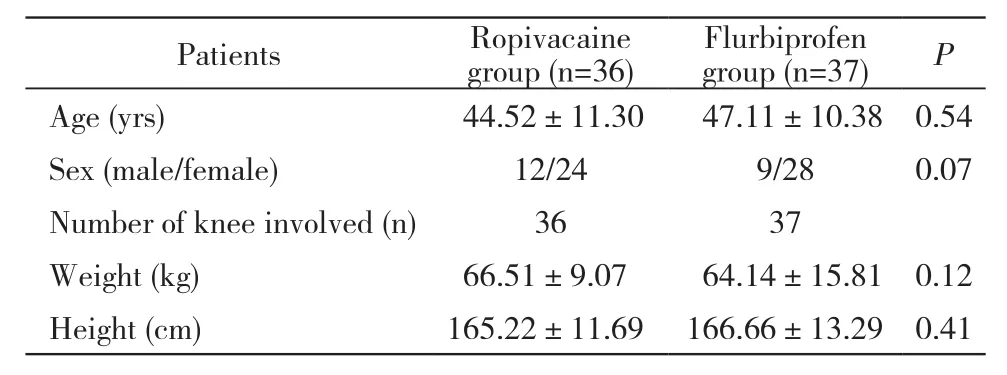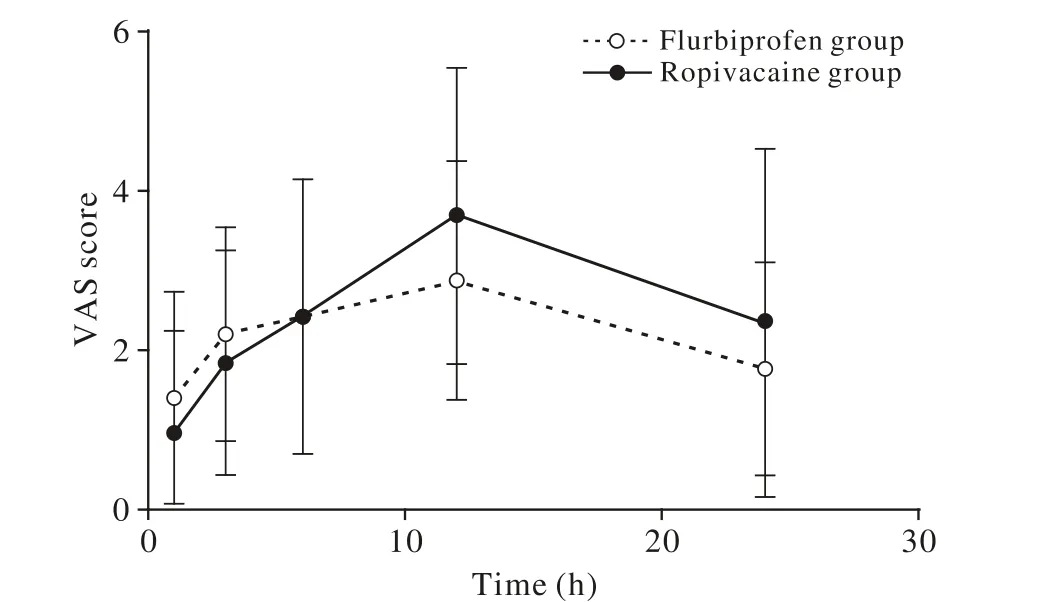局麻关节镜术后关节腔内注射罗哌卡因与静脉注射氟比洛芬酯的镇痛疗效分析
2018-04-14苏祥正李众利刘春晖
苏祥正,李众利,张 浩,李 冀,刘春晖
解放军总医院 骨科,北京 100853
关节镜手术广泛应用于膝骨性关节炎(knee osteoarthritis,KOA),半月板损伤,膝关节内游离体,前交叉韧带重建,膝关节滑膜炎等[1-4]。该手术具有手术创伤小、术后恢复快等优势。对于简单的膝关节疾病,如骨关节炎清理,半月板损伤等,本病区使用局麻的麻醉方式,具有术前准备简单、术后恢复快、住院周期短、麻醉风险小、术后并发症少、住院费用较低等优点。为保证患者关节镜术后早期进行膝关节锻炼,术后镇痛是关节镜手术的重要环节。氟比洛芬酯是常用的术后镇痛药物,术后其单独或联合其他药物镇痛,具有较好的效果[5-6]。氟比洛芬酯为液态前体NSIADs药物[7-8],能够缓解炎性因子导致的疼痛、降低外周痛觉、抑制脊髓和外周前列腺素的合成,从而起到镇痛的效果[9-11]。关节腔内局部注射罗哌卡因也是一类常用术后镇痛方法。为了解两种镇痛方法的局麻关节镜手术后镇痛效果,我们进行了本次临床对照试验研究。
资料和方法
1 研究对象 选取2016年6月- 2017年6月于本院骨科运动医学病区行关节镜手术的KOA患者。纳入标准:1)临床中Kellgren-Lawrence膝关节X线片分级为Ⅱ~Ⅳ级并诊断为KOA;2)口服药物、理疗、康复锻炼等保守治疗效果不佳,膝关节疼痛不缓解;3)无罗哌卡因及氟比洛芬酯过敏史;4)在充分告知后同意参与本课题。排除标准:1)继发性骨性关节炎(如类风湿关节炎、创伤性关节炎、强直性脊柱炎、银屑病关节炎);2)KOA伴发前交叉韧带/后交叉韧带损伤;3)近期曾行关节腔内镇痛药物注射(如皮质醇类药物);4)药物过敏;5)有精神类疾病病史。
2 用药方法 所有患者随机分为两组,罗哌卡因组在手术结束时关节腔及手术入路内注射罗哌卡因共5 ml;氟比洛芬酯组患者术后即刻给予氟比洛芬酯10 mg静滴,1次/12 h,至术后24 h。
3 疗效评价 使用10 cm VAS评分分别于术后1 h、3 h、6 h、12 h和24 h统计患者手术侧膝关节疼痛情况,同时记录患者术后的不良反应。
4 统计学分析 使用SPSS19.0软件进行统计分析,所有计量资料以-x±s表示,正态数据使用t检验,非正态数据采用t'检验;计数资料以率表示,组间采用χ2检验,P<0.05为差异有统计学意义。
结 果
1 纳入对象 一般情况共纳入患者73例,其中罗哌卡因组36例,氟比洛芬酯组37例,两组性别、年龄、身高、体质量等基本资料差异无统计学意义,具有可比性。见表1。
2 两组术后VAS评分比较 两组患者术后膝关节镇痛效果均良好,均未因疼痛剧烈而使用额外镇痛药物。氟比洛芬酯组与罗哌卡因组术后1 h、3 h、6 h、12 h、24 h的 VAS评分 :1.41±1.33 vs 0.98±1.28;2.21±1.34 vs 1.85±1.41;2.53±1.28 vs 2.43±1.72;2.88±1.50 vs 3.69±1.86;1.78±1.34 vs 2.35±2.18。罗哌卡因组在术后1 h、3 h、12 h的VAS评分低于氟比洛芬酯组,其他时间点的VAS评分均高于氟比洛芬酯组,但两组间的VAS评分差异无统计学意义。见图1。
3 药物的不良反应比较 罗哌卡因组未发现与罗哌卡因相关的不良反应,氟比洛芬酯组有6例出现消化道不适症状(胃痛、恶心、呕吐等),两组的不良反应发生率无统计学差异(P=0.08)。

表1 两组膝关节手术患者基线情况比较Tab. 1 Baseline information of patients in two groups

图1 两组术后各时间点VAS评分Fig. 1 VAS scores of the two group at different time points
讨 论
本研究回顾性分析了行局麻关节镜手术的患者术后分别使用局部浸润镇痛及静脉镇痛的效果。静脉使用氟比洛芬酯可能引起胃肠道反应、发热、头痛、嗜睡、过敏等不良反应[12-14],使其受到一定程度的限制。关节镜手术结束时在关节腔及手术入路内注射罗哌卡因为本病区常规术后镇痛方法之一,罗哌卡因有感觉与运动分离、镇痛时间较长等特点[15-17]。局部使用罗哌卡因的不良反应以过敏为主[18-20]。
通过本研究,我们发现关节镜手术结束时关节腔及手术入路内局部注射罗哌卡因能够在术后12 h内取得较好的镇痛效果。与静脉注射氟比洛芬酯相比,其术后6 h内VAS 评分较低,术后12 ~24 h的VAS评分略高,但两组的VAS评分的差异无统计学意义。罗哌卡因组的VAS评分在术后的前12 h较低而12 h后较高,可能是由于罗哌卡因镇痛效果随着时间增加而逐渐降低。因此,我们认为手术结束时局部注射罗哌卡因能够取得与术后静脉注射氟比洛芬酯同样的镇痛效果。因其为手术结束时的操作,能够避免术后患者额外静脉用药,减少患者的术后处理及护理工作量,减少住院时间,节省住院费用。
本研究发现局部注射罗哌卡因未出现不良反应,而氟比洛芬酯组少量患者出现不同程度的胃肠道不良反应。两组的不良反应发生率无统计学差异,我们认为可能与本研究纳入的患者例数较少有关;此外,局部注射较静脉给药并发症少,因此罗哌卡因组的并发症少于氟比洛芬酯组与给药方法有着较大的关系。
总之,我们认为局麻关节镜术后关节腔及手术入路内局部注射罗哌卡因能够较好地控制术后疼痛,与静脉注射氟比洛芬酯有相似的镇痛效果但不良反应更少。
1 Lee DJ, Elfar JC. Utility of Arthroscopic Surgery for Osteoarthritis of the Knee[J]. Geriatr Orthop Surg Rehabil, 2015, 6(1): 47-49.
2 Krych AJ, Stuart MJ, Levy BA. Arthroscopic partial meniscectomy for degenerative meniscal tear[J]. N Engl J Med, 2014, 370(13):1259.
3 Steadman JR, Briggs KK, Matheny LM, et al. Ten-year survivorship after knee arthroscopy in patients with Kellgren-Lawrence grade 3 and grade 4 osteoarthritis of the knee[J]. Arthroscopy, 2013, 29(2):220-225.
4 Aaron RK, Skolnick AH, Reinert SE, et al. Arthroscopic debridement for osteoarthritis of the knee[J]. J Bone Joint Surg Am, 2006, 88(5): 936-943.
5 Al Haydar M, Abid HR, Sunderland B, et al. Metal organic frameworks as a drug delivery system for flurbiprofen[J]. Drug Des Devel Ther, 2017, 11 : 2685-2695.
6 Wang K, Luo J, Zheng L, et al. Preoperative flurbiprofen axetil administration for acute postoperative pain: a meta-analysis of randomized controlled trials[J]. J Anesth, 2017, 31(6): 852-860.
7 Zhang L, Zhu J, Xu L, et al. Efficacy and safety of flurbiprofen axetil in the prevention of pain on propofol injection: a systematic review and meta-analysis[J]. Med Sci Monit, 2014, 20 : 995-1002.
8 Hao J, Wang K, Shao Y, et al. Intravenous flurbiprofen axetil to relieve cancer-related multiple breakthrough pain: a clinical study[J]. J Palliat Med, 2013, 16(2): 190-192.
9 Liu ZF, Chai XQ, Chen KZ. Flurbiprofen axetil enhances analgesic effect of fentanyl associated with increase in β-endorphin levels[J].J Anesth, 2011, 25(5): 679-684.
10 Wang Y, Zhang HB, Xia B, et al. Preemptive analgesic effects of flurbiprofen axetil in patients undergoing radical resection of esophageal carcinoma via the left thoracic approach[J]. Chin Med J,2012, 125(4): 579-582.
11 Wakai A, Lawrenson JG, Lawrenson AL, et al. Topical non-steroidal anti-inflammatory drugs for analgesia in traumatic corneal abrasions[J]. Cochrane Database Syst Rev, 2017, 5 : CD009781.
12 Aptel F, Colin C, Kaderli S, et al. Management of postoperative inflammation after cataract and complex ocular surgeries: a systematic review and Delphi survey[J]. Br J Ophthalmol, 2017,101(11): 1-10.
13 Blazaki S, Tsika C, Tzatzarakis M, et al. Pharmacokinetics and efficacy of intraocular flurbiprofen[J]. Albrecht von Graefes Archiv fur klinische und experimentelle Ophthalmologie, 2017, 255(12):2375-2380.
14 Kuroda H, Mizuno H, Dejima H, et al. A retrospective study on analgesic requirements for thoracoscopic surgery postoperative pain[J]. J Pain Res, 2017, 10 : 2643-2648.
15 da Silva CMG, Franz-Montan M, Limia CEG, et al. Encapsulation of ropivacaine in a combined (donor-acceptor, ionic-gradient)liposomal system promotes extended anesthesia time[J]. PLoS ONE, 2017, 12(10): e0185828.
16 Hazarika R, Parua S, Choudhury D, et al. Comparison of Bupivacaine Plus Magnesium Sulfate and Ropivacaine Plus Magnesium Sulfate Infiltration for Postoperative Analgesia in Patients Undergoing Lumbar Laminectomy : A Randomized Double-blinded Study[J]. Anesth Essays Res, 2017, 11(3): 686-691.
17 Chethanananda TN, Shashank MR, Madhu N, et al. Comparative efficacy of minimal concentration of racemic bupivacaine (0.0625%)with fentanyl and ropivacaine (0.1%) with fentanyl for epidural labor analgesia[J]. Anesth Essays Res, 2017, 11(3): 583.
18 Choi SW, Cho SJ, Moon HW, et al. Effect of Intercostal Nerve Block and Nephrostomy Tract Infiltration with Ropivacaine on Postoperative Pain Control after Tubeless Percutaneous Nephrolithotomy : a Prospective, Randomized, and Case-Controlled Trial[J/OL]. https://www.sciencedirect.com/science/article/pii/S0090429517313122?via%3Dihub.
19 Djerada Z, Feliu C, Cazaubon Y, et al. Population Pharmacokinetic-Pharmacodynamic Modeling of Ropivacaine in Spinal Anesthesia[J/OL]. https://link.springer.com/article/10.1007%2Fs40262-017-0617-2.
20 Singh M, Pathak A, Khan AL, et al. Comparative Study of Clonidine with Ropivacaine versus Ropivacaine Alone in Epidural Anesthesia for Lower Limb Orthopedic Surgery[J]. Anesth Essays Res, 2017,11(4): 1035-1039.
